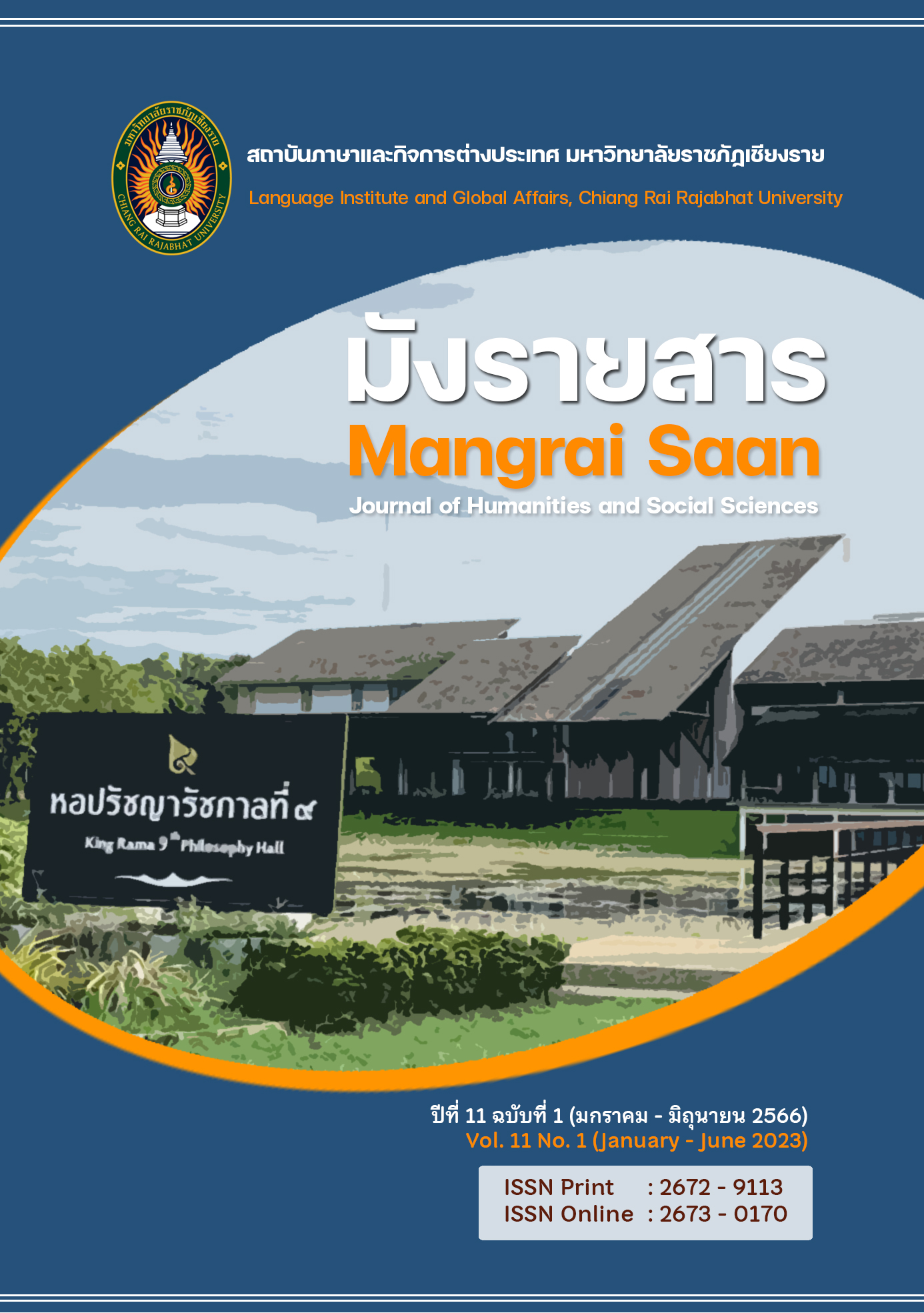“Ngu Ngon Thong” Tale: The study of the relationship between man and nature based on the Ecocriticism theory
Main Article Content
Abstract
This research article aims to examine: 1. The relations between human and nature 2. The representation of nature 3. The literary merit of a tale by investigating Ngu Ngon Thong (gold-crested snake) by Mala Khamchan. The conclusion proved that there are two types of relations between humans and nature: humans being dependent on nature and humans being destructive towards nature. There are 3 types of representations of nature in Ngu Ngon Thong: the representation of nature as a direct or indirect benefactor towards humans, the representation of nature as a belief, and the representation of nature as a teacher to humans. From the investigation, there are 3 literary merits that Ngu Ngon Thong conveys: the value of being grateful towards benefactors, be it human or nature, the value of a supernatural tale in Thai culture, and the social value that portrays the social inequality of the North Thai minorities. All in all, it can be concluded that nature is woven into the customs of humans; thus, humans are to respect and be grateful to nature.
Article Details

This work is licensed under a Creative Commons Attribution-NonCommercial-NoDerivatives 4.0 International License.
The authors should ensure all the contents and information of the articles published in Mangraisaan. The editors do not share any related responsibility.
References
ดีสไทย. (ม.ป.ป.). ชุมเห็ดเทศ : งานวิจัยและสรรพคุณ 17 ข้อ. สืบค้นเมื่อ 25 กันยายน 2565, จาก https://bit.ly/3fSXzjv
ดีสไทย. (ม.ป.ป.). ไพล : งานวิจัยและสรรพคุณ 27 ข้อ. สืบค้นเมื่อ 25 กันยายน 2565, จาก https://bit.ly/3fNw2Ql
ธัญญา สังขพันธานนท์. (2556). วรรณคดีสีเขียว กระบวนทัศน์และวาทกรรมธรรมชาติในวรรณคดีไทย. ปทุมธานี: นาคร.
ธัญญา สังขพันธานนท์. (2559). แว่นวรรณคดี ทฤษฎีร่วมสมัย. ปทุมธานี: นาคร.
บางกอกไลฟ์นิวส์. (ม.ป.ป.). ‘แพทย์แผนไทย’ แนะ ตักบาตร ‘วันมาฆบูชา’ ด้วย ‘ข้าว’ มีสรรพคุณทางยา. สืบค้นเมื่อ 25 กันยายน 2565, จาก https://bit.ly/3MfJn04
ประคอง นิมมานเหมินท์. (2551). นิทานพื้นบ้านศึกษา. (พิมพ์ครั้งที่ 3). กรุงเทพฯ: โครงการเผยแพร่งานวิชาการ คณะอักษรศาสตร์ จุฬาลงกรณ์มหาวิทยาลัย.
ประพนธ์ เรืองณรงค์ และเสาวลักษณ์ อนันตศานต์. (2545). ภูมิปัญญาทางภาษา. กรุงเทพฯ: โรงพิมพ์ไทยวัฒนาพานิช.
พัชนุช เครือเจริญ. (2557). “เมียน้อย” ภาพสตรีชายขอบที่สื่อผ่านเพลงลูกทุ่ง. วิทยานิพนธ์ปริญญาศิลปศาสตรมหาบัณฑิต, มหาวิทยาลัยขอนแก่น. ขอนแก่น.
มาลา คำจันทร์. (2551). นิทานมาลา 1 เหรียญเวทมนตร์. (พิมพ์ครั้งที่ 2). กรุงเทพฯ: สำนักพิมพ์เคล็ดไทย.
วรรณะ สอน และราชันย์ นิลวรรณาภา. (2563). ภาพแทนธรรมชาติในนิทานพื้นบ้านเขมร. วารสารสังคมศาสตร์และมานุษยวิทยาเชิงพุทธ. 5(8), 196-210.
สันติวัฒน์ จันทร์ใด. (2550). การใช้วัฒนธรรมท้องถิ่นภาคเหนือในการสร้างสรรค์นวนิยายของ มาลา คำจันทร์. วิทยานิพนธ์ปริญญาอักษรศาสตรมหาบัณฑิต, จุฬาลงกรณ์มหาวิทยาลัย. กรุงเทพฯ.
สุภาพร คงศิริรัตน์. (2564). นิบาตชาดกเรื่องพระเจ้า 500 ชาติ: การศึกษาวรรณกรรมวิจารณ์เชิงนิเวศ. Proceedings งานประชุมวิชาการระดับชาติและนานาชาติของเครือข่ายความร่วมมือวิชาการวิจัยสายมนุษยศาสตร์และสังคมศาสตร์ ครั้งที่ 14, วันที่ 15-16 กรกฎาคม 2564. หน้า 537-549. https://bit.ly/3ZD2NkC
สุภาพร คงศิริรัตน์. (2565). ศาสนาที่ปรากฏในชาดกเรื่องพระเจ้า 500 ชาติ ฉบับพิสดาร ของปุ้ย แสงฉาย. วิวิธวรรณสาร. 6(2), 25-44. https://shorturl.asia/PJtxw
เสฐียรโกเศศ. (2515). เมืองสวรรค์ ผีสาง เทวดา. พระนคร: บรรณาคาร.
เสฐียรโกเศศ. (2521). การศึกษาเรื่องประเพณีไทยและชีวิตชาวไทยสมัยก่อน. กรุงเทพ: คลังวิทยา.

